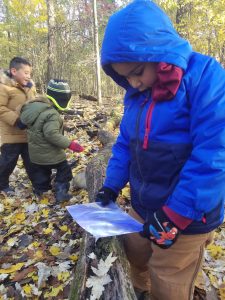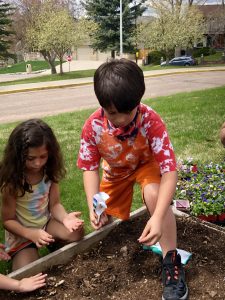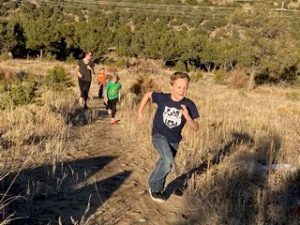Nature Learning Activities for Kids and Why They Are Important
by Justine Santos, parent
Do you encourage your kids to get outdoors and get a little dirty? Because of COVID-19 precautions, many kids are sitting in front of a computer for their lessons these days instead of physically going to school. This is keeping kids away from traditional PE and recess, outdoor activities that used to be part of their daily routine.
Take advantage of having your children at home by giving them time each day to learn about nature. They’ll even build up their immune system by getting their hands in the dirt. Get them out into the environment with activities that not only provide fresh air but teach science and more.
Bug Hunting
 If your kids say “Ewww” to bugs, teach them there’s often nothing to be afraid of. Insects are the largest animal group on Earth and play an important role in the ecosystem.
If your kids say “Ewww” to bugs, teach them there’s often nothing to be afraid of. Insects are the largest animal group on Earth and play an important role in the ecosystem.
What better way for kids to learn about bugs than seeing them up close? Head outside with a magnifying glass, a small container, a notebook, and a pencil. Look around bushes, flowers, and the base of trees. Turning over rocks will usually turn up bugs.
When you find a harmless bug, carefully put it in the container for a better look. Don’t forget to put it back in the wild when you’re finished.
Older children will enjoy looking online later for more information on the insects they found. This is also a good opportunity to learn which bugs they should avoid.
Outdoor Art Projects
Turn the outdoors into your child’s art class! With so many colors and textures to choose from, kids will have a blast creating something they can keep.
Rock Art
Rocks are never in short supply. Find them in wooded areas, near lakes or creeks, in flower beds, or next to roads. Your child can identify the types of rocks by using a chart and can learn about how rocks are formed. Then, get busy decorating!
Paint rocks to look like ladybugs, fruits, animals, or rainbows. Cover them in glue and roll them in glitter. Melt broken crayons and pour them over the rocks. Or write positive messages on the rocks and leave them as surprises for neighbors.
Leaf Rubbing
This activity gives kids a closer look at the structure of leaves, which is useful when studying plants.
Have them collect leaves of different shapes and sizes. Use this time to compare the different leaves, whether they come from trees, shrubs, or flowers. Point out the difference between evergreen trees and deciduous trees.
Once indoors, your child will place the leaves on a table with the BOTTOM side facing up, then put a thin sheet of paper on top of it. Using the side of a crayon, rub it gently over the leaf. While crayons work best, you could use colored pencils or even a regular pencil.
When finished, frame the paper for display in your child’s room.
Gardening
 You don’t need a huge backyard or a whole lot of tools to create a garden. If you have some extra space, section off a small plot for planting. Gardening teaches kids about the stages of plant growth, from seed to fruit or vegetable bearing. It also benefits a child’s motor skills and impacts their senses of touch, smell, and sight.
You don’t need a huge backyard or a whole lot of tools to create a garden. If you have some extra space, section off a small plot for planting. Gardening teaches kids about the stages of plant growth, from seed to fruit or vegetable bearing. It also benefits a child’s motor skills and impacts their senses of touch, smell, and sight.
Even apartment dwelling kids can get their hands in the dirt. Container gardens take up little space but still allow children the chance to grow veggies or flowers. Find a window sill that gets plenty of sunshine. Some of the best choices to grow in containers are herbs, beets, tomatoes, potatoes, and lettuce.
Or really think outside the box and let your kids create a rain garden. The only thing kids love more than dirt is playing in water and mud. A rain garden will help solve any drainage issues in your yard, and attract butterflies and other pollinators. Let your kids choose the plants that will absorb stormwater runoff.
Hiking
 Take a hike! You can find free trails nearby or visit state and national parks for a small fee. One of the biggest benefits of hiking is exercise. Not just walking but climbing on rocks and balancing on fallen trees builds agility.
Take a hike! You can find free trails nearby or visit state and national parks for a small fee. One of the biggest benefits of hiking is exercise. Not just walking but climbing on rocks and balancing on fallen trees builds agility.
Expand the backyard bug hunt to the trail, where kids are sure to find more exciting insects. They may even see mammals like raccoons, squirrels, foxes, and deer, depending on where you live.
Hiking — like bug hunting, outdoor art projects, and gardening — takes kids away from the tablet or computer and helps them de-stress, all while learning about Earth and its inhabitants.
Justine Santos made her camping debut at age 3 months. The nature habit stuck, and now she hikes, skis and rides mountain bikes in as many natural areas as she can, often with her own two children in tow.
Categories: Health at Home, Physical Activity, PE, & Play